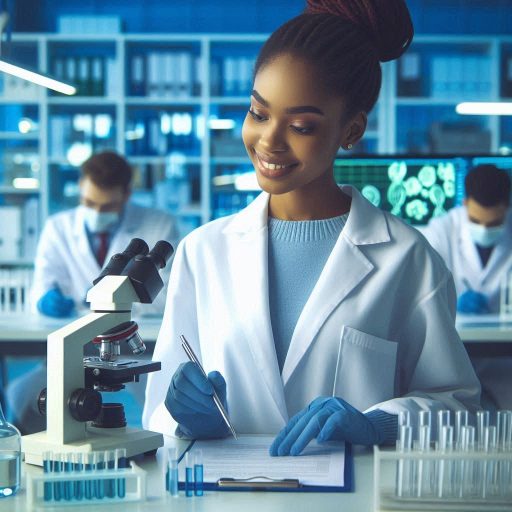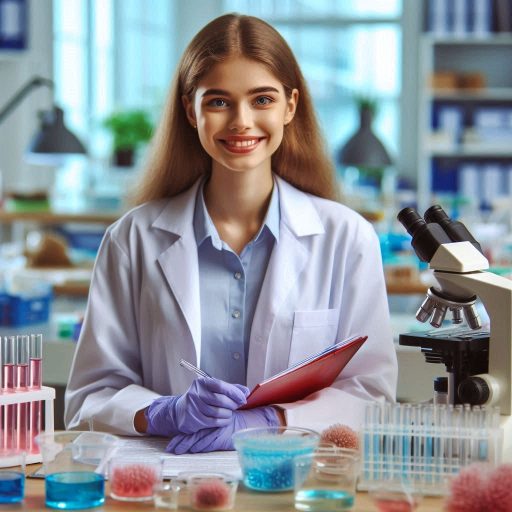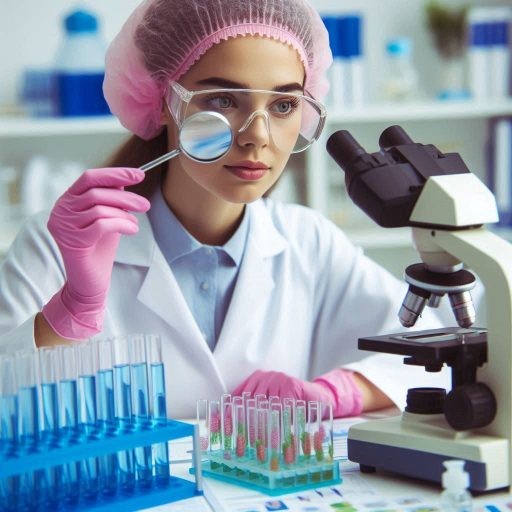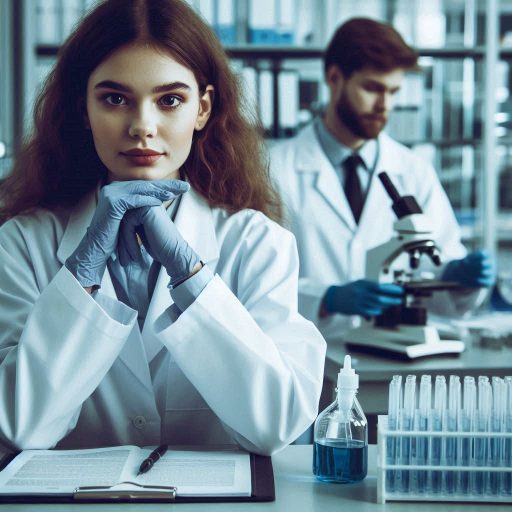Introduction
Microbiologist in Environmental Science is a scientist who studies microorganisms such as bacteria, fungi, viruses, and algae.
These microorganisms play vital roles in various ecosystems, including soil, water, and air.
Microbiologists focus on understanding how these tiny organisms interact with their environment and influence broader ecological systems.
They also investigate how microorganisms contribute to processes like nutrient cycling, pollution breakdown, and disease prevention.
Environmental science, on the other hand, is an interdisciplinary field that studies the environment and how humans impact it.
This field combines biology, chemistry, geology, and physics to explore solutions to environmental problems.
Environmental scientists aim to improve our understanding of natural processes and develop ways to protect ecosystems.
Addressing climate change, pollution, and resource depletion are key aspects of environmental science.
Microbiologists play a crucial role in environmental science by examining how microorganisms affect and maintain environmental balance.
They work to identify microbial species that break down pollutants, improve soil health, or control harmful pathogens.
Their research helps develop sustainable practices for agriculture, waste management, and conservation efforts.
Importance of studying microorganisms in the environment
Microorganisms are essential for nutrient cycling and decomposition
Microorganisms play a crucial role in maintaining environmental balance.
Studying microorganisms in the environment reveals their importance in nutrient cycling and decomposition.
These tiny organisms break down organic matter, releasing essential nutrients into the soil.
This process enriches ecosystems, ensuring plants and animals thrive.
Microorganisms are essential in nutrient cycling, transforming nitrogen, carbon, and phosphorus into usable forms.
Nitrogen-fixing bacteria, for example, convert atmospheric nitrogen into a form plants can absorb.
Without microorganisms, ecosystems would struggle to maintain nutrient availability, leading to poor soil health and reduced agricultural productivity.
Decomposition is another key function of microorganisms in the environment.
They break down dead plants and animals, recycling nutrients back into the soil.
This decomposition process prevents the accumulation of organic waste, which could otherwise lead to environmental issues.
Microorganisms efficiently convert complex materials into simpler compounds, contributing to overall ecosystem health.
Microorganisms Can Be Indicators of Environmental Health
Microorganisms also serve as indicators of environmental health.
By studying microbial communities, scientists can assess the condition of ecosystems.
Changes in microbial populations often reflect shifts in environmental conditions, such as pollution or climate change.
Monitoring these microorganisms helps detect early signs of environmental stress, allowing timely interventions to protect ecosystems.
For instance, the presence of certain bacteria can indicate water pollution.
Pathogenic bacteria, such as E.coli, signal contamination in water sources, posing risks to both human health and wildlife.
By monitoring these microbial indicators, environmental scientists can identify polluted areas and develop strategies for remediation.
This proactive approach helps maintain clean water supplies and preserve ecosystems.
Understanding Microorganisms Helps in Developing Sustainable Environmental Practices
Understanding microorganisms is essential for developing sustainable environmental practices.
Microbiologists study microbial processes to improve waste management, pollution control, and resource conservation.
In agriculture, for example, scientists use beneficial microorganisms to enhance soil fertility and reduce the need for chemical fertilizers.
This sustainable approach promotes healthier ecosystems and minimizes the environmental impact of farming.
In pollution control, microorganisms are used in bioremediation, a process where microbes break down harmful pollutants.
Certain bacteria can degrade oil spills, while others can neutralize toxic chemicals in soil and water.
Microbiologists continue to explore new ways to harness these capabilities, providing environmentally friendly solutions to pollution.
Microbiologists also study microorganisms’ role in climate change mitigation.
Some microbes sequester carbon, reducing greenhouse gas emissions.
By understanding these processes, scientists can develop strategies to enhance microbial activity, helping to combat climate change.
In summary, studying microorganisms is vital for understanding environmental health and developing sustainable practices.
Microorganisms play essential roles in nutrient cycling, decomposition, and pollution monitoring.
Harnessing microbial processes offers innovative solutions to environmental challenges, promoting long-term ecological stability.
Read: Profiles in Success: Leading Chemists of the 21st Century in the US
Microbiologist’s role in studying water quality
Monitoring microbial pollution in water bodies
Microbiologists play a crucial role in studying water quality, focusing on microbial pollution and its environmental impact.
They monitor water bodies, testing for the presence of harmful microorganisms that pose risks to human health and ecosystems.
By identifying microbial contamination, they help safeguard water sources from pollution caused by industrial runoff, sewage discharge, and agricultural activities.
Monitoring microbial pollution involves collecting water samples from lakes, rivers, and groundwater systems.
Microbiologists analyze these samples to detect bacteria, viruses, and protozoa that may cause diseases.
Pathogens like Escherichia coli and Salmonella are common indicators of water contamination.
Their presence highlights the need for immediate intervention to prevent outbreaks of waterborne illnesses.
Microbiologists also track how pollution levels change over time, providing crucial data for environmental assessments.
Identifying Harmful Pathogens in Water Sources
In addition to monitoring, microbiologists identify harmful pathogens present in water sources, which may include disease-causing bacteria, viruses, and parasites.
They use advanced techniques like polymerase chain reaction (PCR) to detect microbial DNA in contaminated water.
By identifying these pathogens, they assess the risks to public health, ensuring proper treatment methods are applied.
Their findings are essential for water safety, especially in regions relying on untreated surface water for drinking or irrigation.
Developing Strategies to Improve Water Treatment Processes
Once microbiologists identify contaminants, they develop strategies to improve water treatment processes.
They work closely with engineers to design more effective filtration systems, disinfection methods, and waste management practices.
Their expertise ensures that water treatment plants can efficiently remove harmful microorganisms before water reaches homes and businesses.
Microbiologists also help optimize existing treatment protocols, making them more energy-efficient and cost-effective while ensuring compliance with environmental regulations.
Microbiologists also research innovative ways to reduce microbial pollution at its source.
They explore the use of biological treatments, such as harnessing bacteria to break down pollutants in water systems.
These methods provide sustainable solutions to water pollution while minimizing chemical use in treatment processes.
Their work plays a key role in the global effort to protect water resources and combat water scarcity.
Moreover, microbiologists contribute to public education and awareness efforts.
By communicating their research findings, they help inform communities about the importance of protecting water sources and adopting safe water usage practices.
Their role in advocacy strengthens efforts to preserve water quality and encourages government agencies to implement stricter water quality standards.
Through their work in monitoring, identifying pathogens, and improving water treatment processes, microbiologists play a vital role in protecting water quality.
Their contributions are essential for safeguarding public health and maintaining sustainable water systems.
Read: The Life and Times of a U.S. Physicist: A Day in Detail
Microbiologist’s role in soil health
Studying Soil Microorganisms and Their Impact on Plant Growth
Microbiologists play a crucial role in maintaining and improving soil health.
They study soil microorganisms and their relationship with plant growth.
These microorganisms include bacteria, fungi, and other microscopic organisms that interact with plants in various ways.
Microbiologists focus on understanding how these organisms contribute to soil fertility and sustainability.
One of the key responsibilities of microbiologists is studying soil microorganisms to improve crop productivity.
They analyze how different types of bacteria and fungi help plants absorb nutrients more effectively.
Some microorganisms form symbiotic relationships with plants, improving nutrient uptake and overall plant health.
For example, nitrogen-fixing bacteria convert atmospheric nitrogen into forms that plants can absorb, enhancing soil fertility.
Developing Methods to Enhance Soil Fertility Using Microbiology
Microbiologists also work on developing methods to enhance soil fertility using microbiology.
By identifying beneficial microorganisms, they can create biofertilizers that reduce the need for chemical fertilizers.
These biofertilizers can increase soil nutrient levels, leading to healthier crops and more sustainable agricultural practices.
Microbiologists help optimize these natural processes, allowing farmers to maintain soil fertility without harming the environment.
In addition to improving fertility, microbiologists monitor soil quality in agricultural systems.
They assess how different farming practices impact microbial communities and soil health.
Intensive agriculture, for example, can reduce microbial diversity, leading to soil degradation.
Microbiologists study ways to mitigate these effects by promoting practices like crop rotation and organic farming, which support healthy microbial populations.
Monitoring Soil Quality in Agricultural Systems
Microbiologists also help in the restoration of degraded soils.
They study how microorganisms break down organic matter and recycle nutrients back into the soil.
By understanding these processes, microbiologists develop techniques to restore depleted soils and enhance their long-term fertility.
Their research supports the sustainable management of agricultural land, helping to ensure food security for future generations.
Moreover, microbiologists are involved in preventing soil pollution.
They study how microorganisms break down harmful chemicals, such as pesticides and heavy metals.
This knowledge helps develop bioremediation techniques that use microorganisms to clean contaminated soils.
These efforts protect ecosystems and human health while promoting sustainable land use practices.
Overall, microbiologists contribute significantly to maintaining and improving soil health.
By studying soil microorganisms and developing microbiological methods to enhance soil fertility, they promote sustainable agriculture.
Monitoring soil quality also helps ensure long-term environmental sustainability.
Through their work, microbiologists protect vital ecosystems and support agricultural productivity, playing a key role in environmental science.
Read: Salary Ranges: What to Expect as a Physicist in the USA
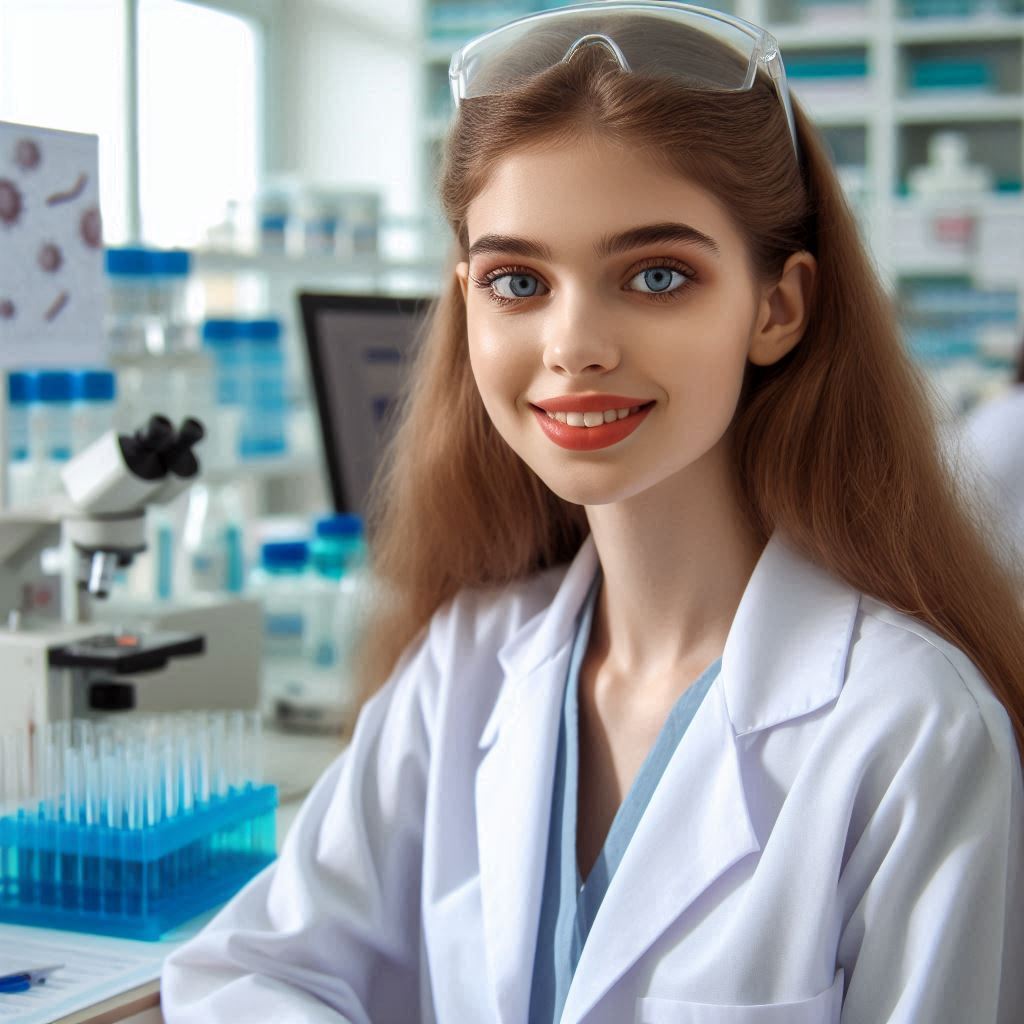
Microbiologist’s Role in Bioremediation
Using Microorganisms to Clean Up Contaminated Environments
Microbiologists play a crucial role in bioremediation by harnessing the power of microorganisms to clean up contaminated environments.
They use naturally occurring or engineered microbes to break down harmful pollutants, transforming them into non-toxic substances.
This process can restore polluted soils, water bodies, and air to their natural state, making bioremediation a sustainable solution for environmental restoration.
Developing Microbial Technologies for Waste Treatment
One key area where microbiologists contribute is the use of microorganisms to treat industrial waste.
Many industrial processes release harmful chemicals that can damage ecosystems.
Microbiologists develop microbial technologies that effectively degrade these toxins, helping industries minimize their environmental impact.
By selecting the right microbial strains, microbiologists can target specific pollutants, ensuring efficient waste treatment and reducing the need for harmful chemical treatments.
Restoring Ecosystems Through Biological Remediation Methods
In addition to waste treatment, microbiologists also focus on restoring ecosystems through biological remediation methods.
When natural habitats are disrupted by pollution, such as oil spills or heavy metal contamination, microbiologists intervene to restore balance.
They introduce or stimulate microbial communities that break down the contaminants, allowing ecosystems to recover naturally over time.
This approach is particularly valuable for areas where chemical treatments may cause further harm.
Microbiologists are constantly researching new ways to enhance bioremediation techniques.
By studying microbial behavior, they can optimize the conditions for effective pollutant degradation.
For example, they may adjust temperature, oxygen levels, or nutrient availability to improve microbial activity.
Through continuous innovation, microbiologists are making bioremediation more efficient, cost-effective, and environmentally friendly.
In addition to improving existing techniques, microbiologists are developing new microbial technologies for waste treatment.
Some of these include bioaugmentation, where specific microorganisms are introduced to contaminated sites to accelerate the breakdown of pollutants.
Others involve the use of genetically engineered microbes designed to target and degrade complex pollutants that natural microbes cannot handle.
These advancements expand the scope of bioremediation, allowing it to be applied to a wider range of environmental challenges.
Collaboration between microbiologists and environmental engineers is essential for the success of bioremediation projects.
Microbiologists provide the scientific expertise needed to select and optimize microbial strains, while engineers design the systems to implement these solutions on a large scale.
Together, they develop strategies that not only clean up contaminated environments but also prevent future pollution through sustainable waste management practices.
In short, microbiologists play a vital role in using microorganisms for bioremediation, developing microbial technologies for waste treatment, and restoring ecosystems.
Through their efforts, they contribute to cleaner, healthier environments and help combat the growing problem of pollution.
Read: Physics Specializations: Choosing Your Path in the U.S.
Learn More: Top Universities for Materials Science Degrees
Microbiologist’s role in understanding climate change
Studying Microbial Responses to Environmental Changes
Microbiologists play a crucial role in understanding climate change by studying how microorganisms respond to environmental changes.
Microorganisms are highly sensitive to shifts in temperature, pH, and nutrient availability.
By analyzing these responses, microbiologists provide insights into how ecosystems adapt to climate change.
This knowledge helps predict potential impacts on global biodiversity and ecosystem stability.
Monitoring the Role of Microorganisms in Greenhouse Gas Emissions
Another key area microbiologists explore is the role of microorganisms in greenhouse gas emissions.
Microbes are directly involved in processes like carbon and nitrogen cycling.
Some microbes release gases such as carbon dioxide, methane, and nitrous oxide, which contribute to global warming.
Microbiologists monitor these microbial activities to understand how they influence atmospheric composition.
This research is vital in predicting future trends in greenhouse gas levels.
Transform Your Career Today
Unlock a personalized career strategy that drives real results. Get tailored advice and a roadmap designed just for you.
Start NowDeveloping Strategies to Mitigate Climate Change Using Microbiological Solutions
To mitigate the effects of climate change, microbiologists are developing strategies that harness the power of microbes.
One example is the use of microbes to reduce methane emissions from agriculture.
Certain microbes can break down methane before it reaches the atmosphere.
By applying these microbes in livestock systems or waste management, microbiologists aim to lower methane emissions significantly.
Microbiologists are also exploring microbial solutions to enhance carbon sequestration.
Some microorganisms, like cyanobacteria and algae, can absorb carbon dioxide through photosynthesis.
These microbes can be cultivated and applied in carbon capture technologies.
By boosting natural carbon sinks, microbiologists contribute to reducing the concentration of atmospheric carbon dioxide.
Soil microbiology is another focus area, where microbes play a crucial role in carbon storage.
Microbiologists study soil microbes to determine their role in carbon cycling and storage.
By enhancing microbial activity in soils, they aim to increase the soil‘s capacity to store carbon.
This process could be key in mitigating climate change through natural systems.
Additionally, microbiologists develop bio-based solutions for climate change adaptation.
They work on microbial systems that can degrade environmental pollutants or treat wastewater.
These applications can help industries reduce their environmental footprint, contributing to broader climate resilience.
In fact, microbiologists play a vital role in understanding and addressing climate change.
They monitor microbial activities that affect greenhouse gas emissions and develop innovative solutions to mitigate climate impacts.
Through ongoing research and applied strategies, microbiologists contribute significantly to global climate action.
Their work not only provides insights into how microorganisms respond to environmental changes but also offers practical solutions for reducing greenhouse gases and enhancing ecosystem resilience.
As the effects of climate change intensify, microbiologists’ contributions will become even more critical in developing sustainable approaches for a healthier planet.
Collaboration with other environmental science professionals
Working with Ecologists, Chemists, and Engineers to Address Complex Environmental Challenges
Microbiologists play a crucial role in addressing environmental challenges by collaborating with various environmental science professionals.
They frequently work with ecologists, chemists, and engineers to develop solutions for complex environmental issues.
Their knowledge of microorganisms helps other professionals understand how biological systems impact ecosystems.
When microbiologists collaborate with ecologists, they analyze the relationship between microorganisms and their environment.
This partnership allows both groups to study how microbes affect biodiversity, nutrient cycles, and overall ecosystem health.
Together, they identify strategies to protect endangered species, restore habitats, and maintain biodiversity.
Collaboration with chemists is also essential for addressing environmental challenges.
Microbiologists provide insights into microbial processes that influence chemical reactions in the environment.
This teamwork is particularly important for studying pollution, such as how microbes can break down harmful chemicals in soil and water.
Microbiologists and chemists work together to develop new methods for cleaning up toxic waste through bioremediation.
Engineers also benefit from collaboration with microbiologists, especially when designing systems to treat wastewater or manage waste.
Microbiologists offer expertise in how microorganisms can be used to process and remove contaminants.
By working together, engineers and microbiologists create more efficient systems that reduce environmental impacts and protect public health.
Sharing Research Findings and Collaborating on Interdisciplinary Projects
Sharing research findings is a vital aspect of collaboration.
Microbiologists communicate their discoveries with other environmental professionals to enhance interdisciplinary projects.
By sharing data, they help inform decisions on managing natural resources, controlling pollution, and conserving ecosystems.
Open communication and data-sharing ensure that all professionals have the latest knowledge to make informed decisions.
Collaborating on interdisciplinary projects allows microbiologists to contribute to comprehensive solutions for environmental problems.
These projects might involve studying the role of microbes in carbon sequestration or their ability to degrade plastic waste.
By combining their expertise with that of other professionals, microbiologists help tackle large-scale environmental issues.
Contributing to Policy-Making Decisions on Environmental Issues
In addition to hands-on collaboration, microbiologists contribute to policy-making decisions on environmental issues.
They provide scientific evidence that informs regulations and policies aimed at protecting ecosystems and public health.
Their research helps guide decisions on topics like water quality, pollution control, and the use of pesticides.
By working with policymakers, microbiologists ensure that environmental regulations are based on sound science.
They also advocate for the responsible use of microorganisms in addressing environmental problems.
Their involvement in policy-making contributes to creating sustainable solutions that benefit both people and the environment.
Essentially, microbiologists’ collaboration with environmental science professionals is essential.
Their expertise in microorganisms strengthens interdisciplinary projects, informs policy decisions, and contributes to solving environmental challenges.
Conclusion
Microbiologists play a critical role in environmental science, contributing to the understanding and management of ecosystems.
They help identify and analyze microorganisms that impact soil, water, and air quality.
By studying these microorganisms, microbiologists provide insights into natural processes like nutrient cycling and decomposition.
Their work helps to maintain biodiversity and ensure ecosystem stability.
Microbiologists also focus on pollution control, offering solutions for bioremediation and waste management.
Through bioremediation, they harness microorganisms to break down hazardous substances, turning them into less harmful compounds.
This method is eco-friendly and supports environmental restoration efforts.
Their expertise in waste treatment also ensures cleaner water and healthier habitats.
Another key contribution of microbiologists is monitoring pathogens and preventing the spread of diseases.
They identify harmful microorganisms in the environment and help develop strategies to reduce public health risks.
Microbiologists collaborate with environmental scientists to create safe water supplies and manage disease outbreaks linked to environmental contamination.
The need for continued research and innovation in microbiology is crucial for sustainable environmental management.
Emerging environmental challenges, such as climate change and pollution, require advanced microbiological techniques to mitigate their effects.
Microbiologists are at the forefront of developing technologies to address these issues, including creating bio-based materials.
Enhancing bioprocesses that reduce environmental impacts.
[E-Books for Sale]
The Big Book of 500 High-Paying Jobs in America: Unlock Your Earning Potential
$19.99 • 500 High-Paying Jobs • 330 pages
Explore 500 high-paying jobs in America and learn how to boost your career, earn more, and achieve success!
See All 500 High-Paying Jobs of this E-Book
1001 Professions Without a Degree: High-Paying American Jobs You Can Start Now
$19.99 • 1001 Professions Without a Degree • 174 pages
Discover 1001 high-paying jobs without a degree! Unlock career tips, skills, and success strategies for just $19.99!

